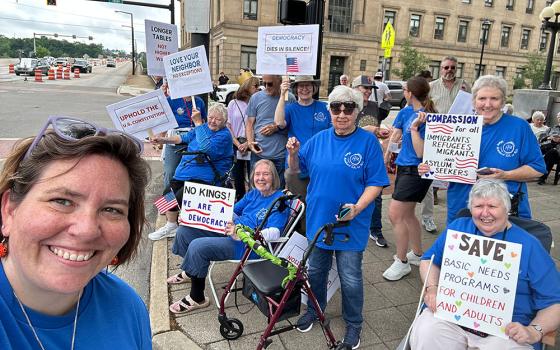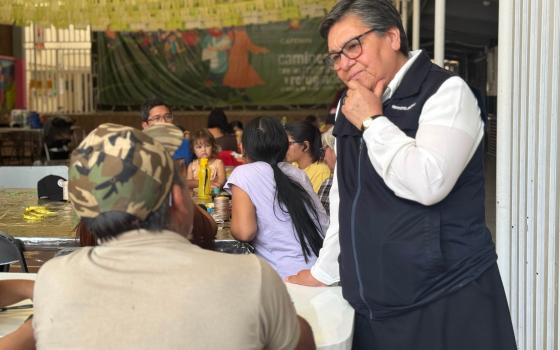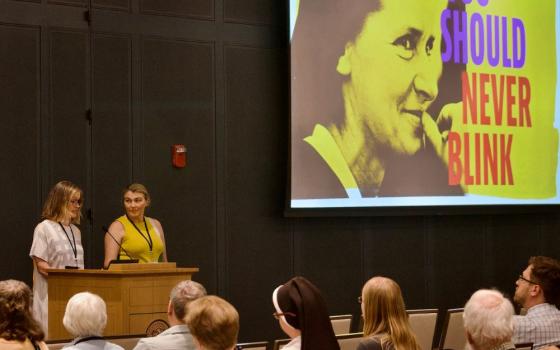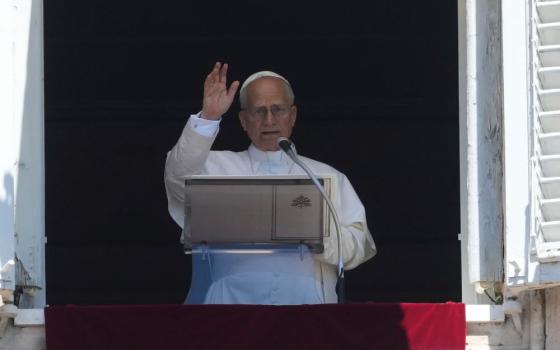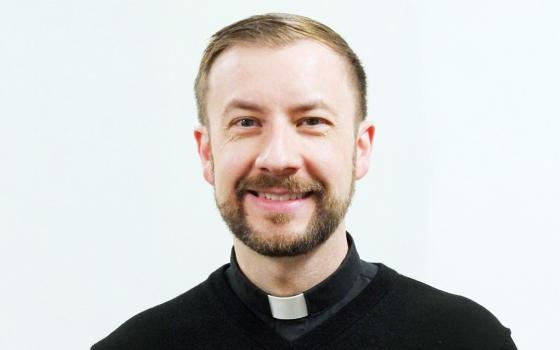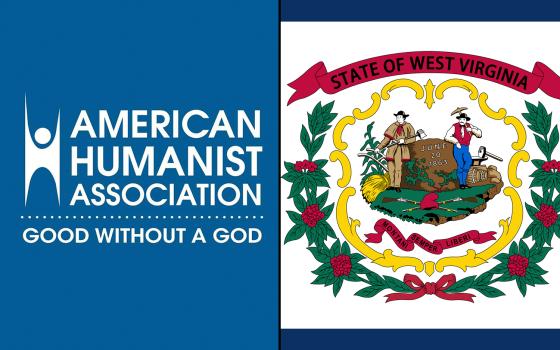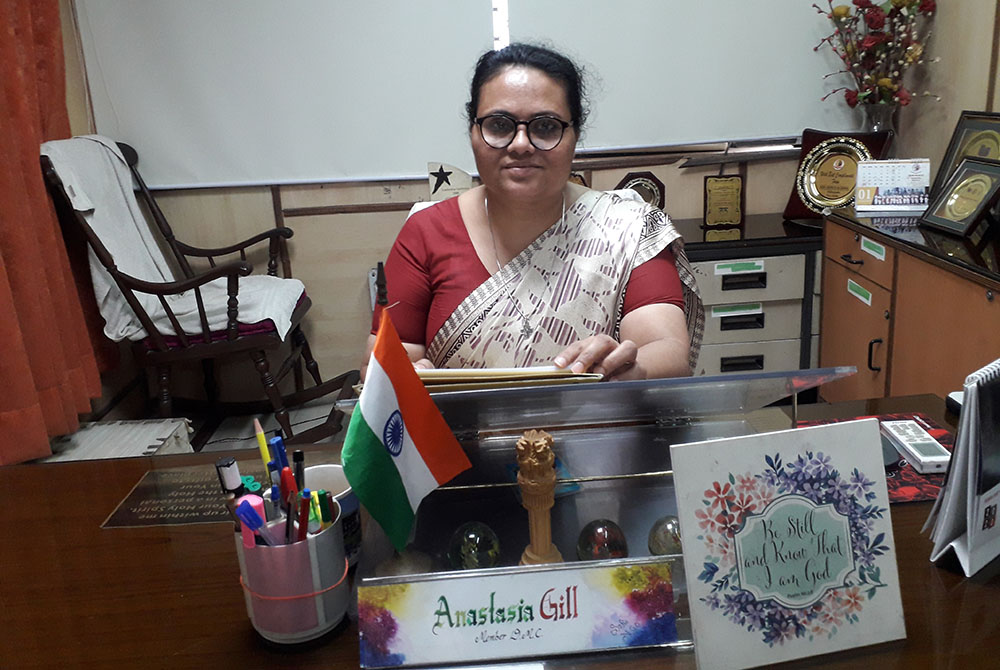
Presentation Sr. Anastasia Gill, a member of the Delhi Minority Commission, in her office in New Delhi (Jessy Joseph)
When U.S. President Donald Trump made his first official visit to India in the last week of February, parts of Delhi, the national capital, were in flames. At least 50 people were killed and hundreds wounded in sectarian riots triggered by the controversial Citizenship Amendment Act the Indian parliament passed last December.
The new law, which allows people of non-Muslim faiths from Afghanistan, Bangladesh and Pakistan to enter India, led to nationwide protests from all sections of society and triggered days of violence between Muslims and Hindus in New Delhi. Muslims and those opposing the new law in India saw the Hindu nationalist party’s action as an effort to remove the country’s secular character and replace it with a Hindu theocratic state.
One of the first Christians to reach out to the riot victims was Presentation Sister Anastasia Gill, a member of the minority commission of the Delhi government. Besides visiting the affected areas and hospitals where the wounded are admitted, Gill also coordinated relief and medical efforts with various voluntary and Christian groups.
Gill, popularly known as Sister Sneha (which means "love"), spoke to Global Sisters Report about her experience with the riot victims.
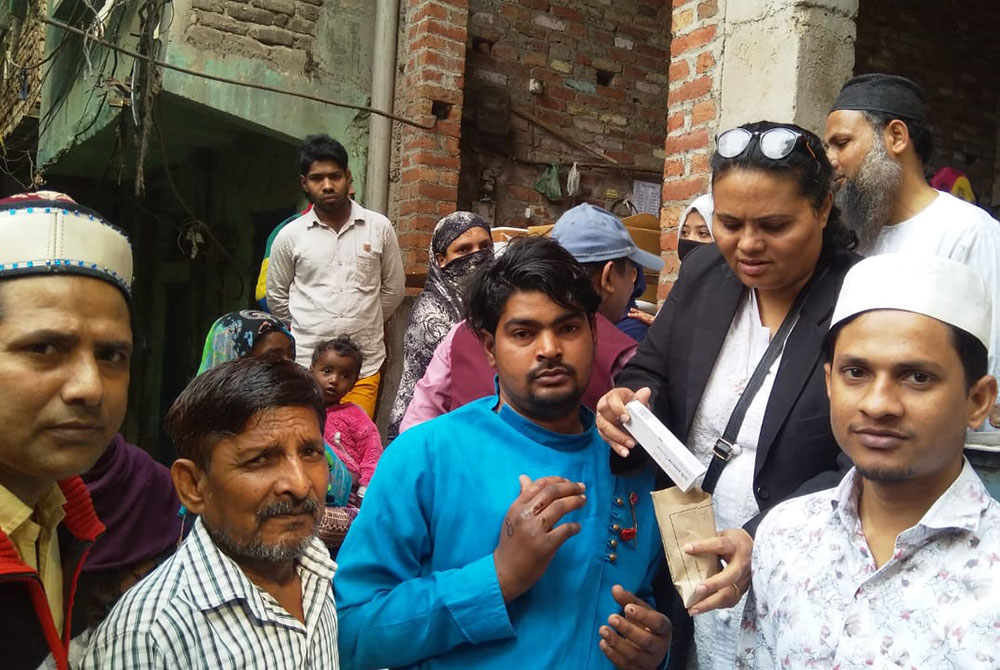
Presentation Sr. Anastasia Gill (right, in black jacket), a member of the Delhi Minority Commission, works in an area in northeast Delhi affected by recent rioting. (Provided photo)
GSR: You were among the first Christians to visit Delhi’s riot-affected areas. What did you see there?
Gill: Violence broke out in Delhi’s northeastern parts on the night of Feb. 23 after groups favoring the CAA [Citizenship Amendment Act] clashed with those opposing it. Shops, houses and vehicles, mostly in Muslim areas, were burnt by mobs armed with pistols, sticks, stones and other materials.
When I visited Guru Teg Bahadur Hospital in East Delhi, many families were waiting there for the bodies of their relatives killed in the riots. Bodies were held up in the hospital morgue as their post-mortem [autopsy] was delayed. People also came looking for missing relatives.
One of the persons I met in the hospital was Kasim Khan from Jaffarabad, [a suburb of New Delhi] a badly affected locality. He was returning with his uncle from night work around 5 a.m. on Feb 25 when a mob confronted them. They asked them for their names, and the mob thrashed them realizing they were Muslims. His uncle sustained serious injuries and was admitted in the intensive care unit. Khan sat outside the hospital with bandages.
Another person I met was a one-day-old girl with her relatives. Her mother died of excessive bleeding during childbirth. The woman could not be taken to a hospital as no ambulance or vehicles could enter their area. I felt a kind of numbness looking at the infant.
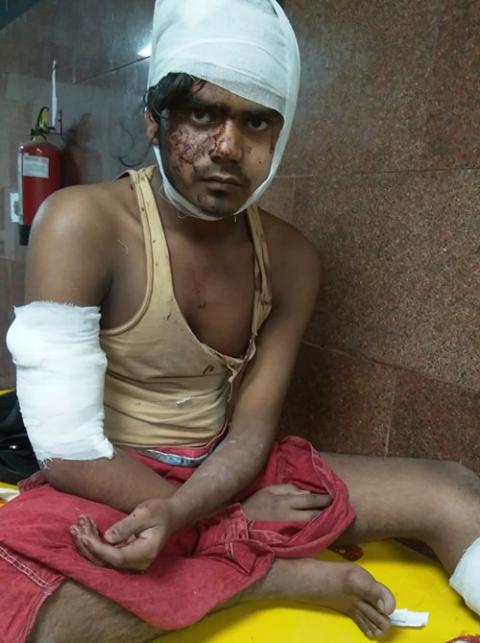
Kasim Khan, one of the victims of the Delhi riots, waits in a corridor outside the Guru Teg Bahadur Hospital in East Delhi after receiving first aid for his wounds. A new citizenship law, allowing people of non-Muslim faiths to enter India, triggered days of violence between Muslims and Hindus in late February, just as U.S. President Donald Trump ended a state visit there. (Provided photo)
What prompted you to visit the riot-hit areas, especially when Christians hesitated to go there?
I believe in action, not issuing statements or conducting prayers for peace. I have been involved in social work for the past 25 years and have been in legal practice for eight years. This is my third year as the Christian member of the Delhi Minority Commission. It is my responsibility to become the voice of the minority community. I would have gone there even if I was not a commission member. Otherwise I would have felt miserable. So, visiting the riot victims and areas was a response to my restless soul.
I also had to use the powers my government post gives me. I could use them to access people in need and assess the ground reality. If I had not met the affected families, I wouldn't have understood the gravity of the situation. The visit also prompted me to ask the hospital authorities to hurry up the post-mortem and hand over the bodies to their relatives.
After visiting the hospitals and riot areas, I met with NGOs and Christian organizations in my office to plan ways to help the victims.
You issued a statement condemning the violence. Did the commission, as a body, condemn it?
Yes it did. After my visit to these places, the commission chairman issued a statement condemning the violence. We have also issued notices to the authorities for action and reports. We have also asked the police to take charge of the law-and-order situation. [The police were accused of remaining passive or supporting the rioters.] We are making the authorities responsible and accountable.
What has been the response of people, especially Christian groups, after you spoke to them?
Christian groups have come forward to help the victims after the initial hesitation. I told the Delhi archbishop that our people have to visit the areas and study what should be done for the affected. The Delhi Archdiocese has organized medical teams to visit the areas and treat the people. Christians of various denominations have joined other groups to bring food and relief materials to the affected.
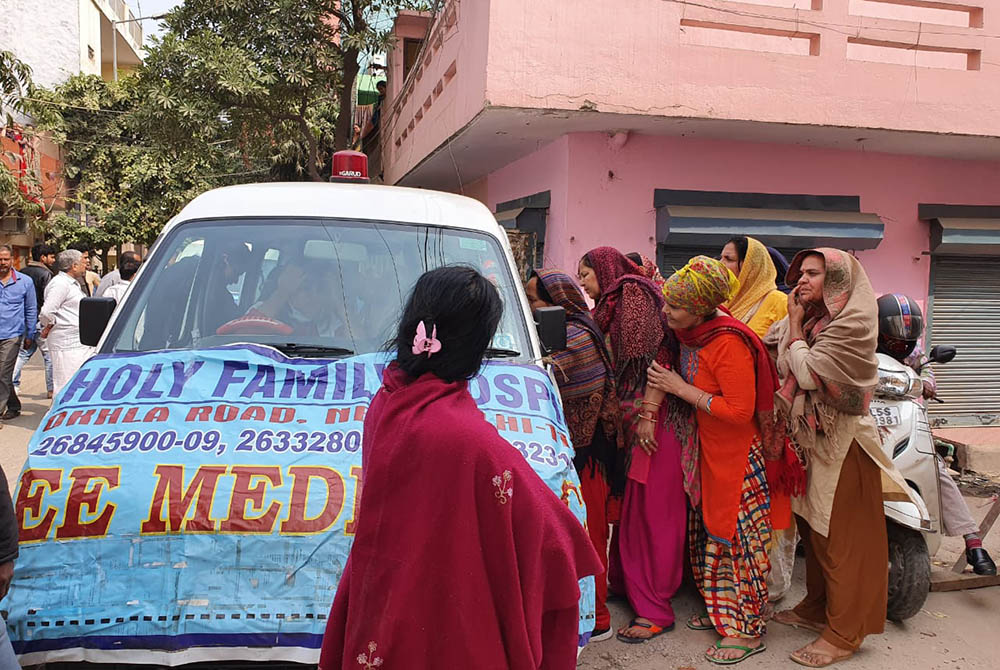
Women of riot-hit areas crowd around an ambulance delivering medicines sent by the Holy Family Hospital of the Delhi Archdiocese. (Provided photo)
Why did this violence occur?
For more than two months, hundreds of people have been on a sit-in along a stretch in Shaheen Bagh (south Delhi) to oppose the CAA. On Feb. 23, the Supreme Court urged the protesters to change the venue as they have blocked a major highway in Delhi. But that did not happen. Then some pro-Hindu politicians made hate speeches that triggered violence in another area in the city.
Did the American president's visit help contain the riots or aggravate the situation?
I suppose we wanted to present a good picture of India to Donald Trump. The Indian government wanted to show the country as a peaceful nation. It wanted to stress the CAA as an internal matter and that we take care of all communities irrespective of their religion, particularly Muslims. I would say it has backfired. The riots have apparently damaged the image of Indian democracy, giving a horrific picture of India to the entire world.
What will be the impact of the riots in future?
People I met said they [Hindus and Muslims] have lived as family for years in their localities. They have participated in the festivals of the other and shared the joys and sorrows of each other. The riots have dampened this spirit. They say they have lost faith in the other, especially after the attackers, who they say were strangers from outside, used rooftops to fire at people. How could the outsiders get access to the terraces, they ask. They say they have been victims of some sinister games of politicians.
Many told me that they would continue to work with the other community. They have houses, shops and other places adjacent to each other. So, they cannot remain suspicious of each other. They want peace and harmony at any cost.
What are you planning for the riot victims?
What we could do is to work on people's desire to start life anew and help foster peace and harmony. We have to help people recover from the trauma. For that, peace committees have to be formed with people of all communities. We have to set up fact-finding teams to assess the type of support and services people need.
Is your congregation involved in this mission?
Yes. Before the riots happened my superiors had allowed Sr. Shalini Mulackal [former president of the Indian Theological Association] and me to join the protests at Shaheen Bagh. Three more sisters also joined the protest. Shalini [Mulackal] joined the Delhi archbishop to visit the riot areas. Both of us shared with our community the ground reality. Like other people, our people too are confused, frightened and perplexed even now.
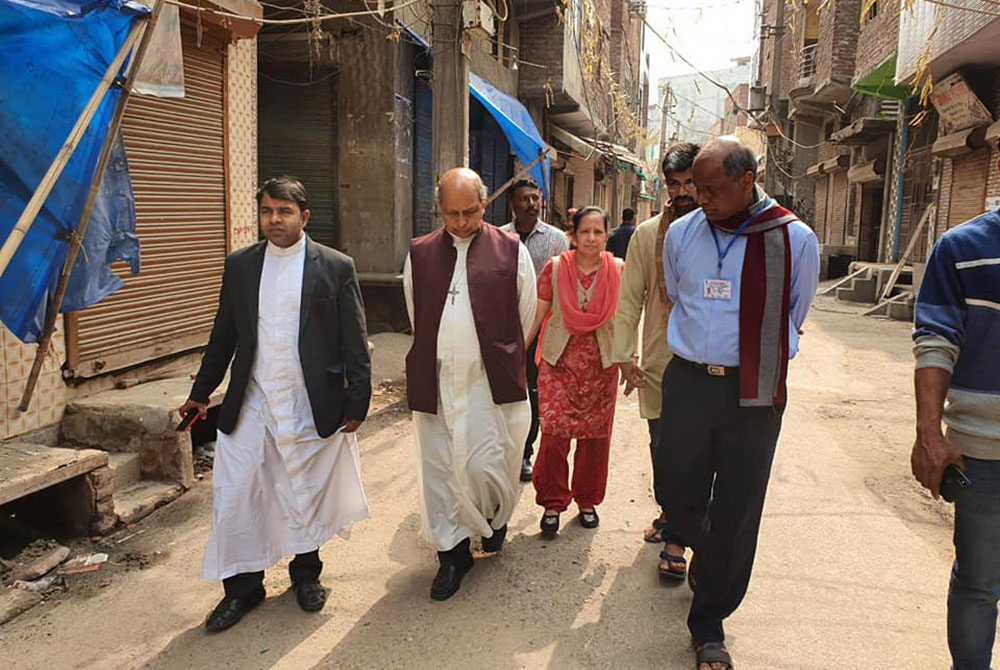
Archbishop Anil Couto of Delhi (second from left) and Sr. Shalini Mulackal (center) visit riot-hit areas of Delhi on February 29. (Provided photo)
What should be done next?
We need to organize individuals, organizations and congregations to help the victims. It has to be a serious commitment. Everyone should know how much time and energy one could spare for this mission.
The church invests so much on interreligious dialogue. Don't you think this is the time to practice dialogue?
Yes, of course. This is what I have been telling the archbishop and those involved in interreligious dialogue. I indirectly challenge these groups to be proactive in times like this. Meetings and prayers are not enough to fulfill Christ's prophetic mission. We can get hundreds of people to come for prayers. But not many would want to stick their necks out to help those in need in situations like this. Bishops and others should not stop by just issuing statements. They should condemn violence and come out to restore peace and harmony. It is risky, but Christ did not evade risks.
Coming back to the commission, what is your role in it?
The Indian government set up the National Commission for Minorities in 1992. The government has recognized six religious communities — Muslims, Christians, Sikhs, Buddhists, Zoroastrians (Parsis) and Jains — as religious minorities.
Each state can set up its own minority commission. The Delhi government set up the commission in 2000. It consists of the chairman and two members [a Christian and a Sikh]. We all have equal powers. We have the power of a first-class magistrate to summon [those accused of violating minority rights] and call for court hearings. We have a court to try cases of attacks on religious minority people. On receiving such complaints, we can summon the deputy commissioner of police and station house officer and others in charge of that place.
The commission also tries to foster peace and harmony among all people. We implement various government welfare projects for the minority groups, such as scholarships for students, loans for housing and education and other welfare programs. We inform people about such projects.
Advertisement
Tell us something about yourself. Why did you become a nun?
I was born in Ranbir Singh Pura in Jammu and Kashmir, close to the international border with Pakistan. We are three sisters and three brothers. I joined the Presentation Sisters [formally, Sisters of the Presentation of the Blessed Virgin Mary] in 1985; influenced by an Irish nun, Loyola Beck, my high school teacher. She visited the poor in families, hospitals, orphanages and prisons. I used to accompany her from fifth grade and was touched by her love, kindness and compassion for the needy.
After first profession in 1989, I taught in the Presentation School in Old Delhi and visited slums near our school. When I told my provincial about my desire to work for the poor, she transferred me to Jahangirpuri, a slum area in the northern part of Delhi, in 1994, where our congregation had just opened a convent. After some time, I went to Mumbai [then Bombay] for a master's in social work. On returning in 2006, I was sent to Bhopal [central India], where I worked for the empowerment of women and rape victims, besides educating Dalit children. I realized the need for legal knowledge after the police cheated us by manipulating cases. After my law studies, I practiced with criminal lawyers.
I feel happy and contented in serving the Lord through the poor and downtrodden.
[Jessy Joseph is a New Delhi-based freelance journalist who earlier worked with Union of Catholic Asian News (UCAN), Asia's largest Church news agency, for nearly 25 years. This story is part of a collaboration between GSR and Matters India, a New Delhi-based news portal that focuses on social and religious news.]
